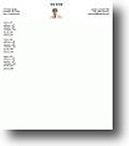When You Will Need One
Getting to know about everything necessary to include in your portfolio is a vital step in the hiring process. Note that your resume should always accompany this reference document. This page is not always needed, but often it will be explicitly requested when you go for an interview. It can't hurt to bring the page with you, but most of the time, don't expect an employer to ask to see it unless they have previously asked for it.
How to Ask for a Reference
Asking someone to speak on your behalf may be difficult if you are unsure about how to go about asking them. It is a fundamental element of learning is how to write a resume reference page. There are two types of references that you can have on a resume, professional and personal. An example of a professional contact would be a supervisor, manager, or even a coworker, whereas a personal contact can be a volunteer director, instructor, or neighbor. Most of the time, you do not want to ask a family member unless they are very distinguished, and you have no other options.
We hope that you feel comfortable enough in your relationship with your contact to speak with them about being your reference. If you need to learn how to be a bit more direct and informative with them, here are some tips.
How to Ask Step-by-Step
- Ask your contacts if they would be willing to speak about you to increase your chances of obtaining the opportunities you are pursuing. Ask them, no matter how well you know them. Getting the contact's permission is necessary to ensure you will get a good recommendation. It also informs them that someone may be contacting them soon on your behalf.
- Start with something like,
"Hello [contact], I have an incredible opportunity to intern/work/volunteer at [organization/company], and I was wondering if I could include you as a reference. Attached is my resume, if you have any questions feel free to contact me. I appreciate your time, thank you!"
If they contact you after this email or conversation, you can continue speaking with them if they request any additional information. - Solidify your contact information when you connect with your references, make sure that all the information in your file is up to date. Also, ask them by which method of communication would they prefer to be reached.
- Send a copy of your resume to your contact if necessary, so that they can become familiar with your accolades and experience outside of what they already know about you. You should also explain what company and position for which you are currently in the process of applying.
The actual set-up of the page is quite simple. The page is merely a list of your references' information in a particular order. The preferable order is alphabetical, but with professional contacts listed before personal ones.
You should print your page on 8.5″ x 11″ paper and match the rest of your portfolio. Evenly space the listings don't cram them together. There should be no more than three to five references. Any less will make you look unreliable, but any more will become tedious for the recruiter to sift through.
The first six lines of the reference page are composed of the contact information. These lines include their name, job title, street address, city, state, zip code, phone number, and email address of their office or place of business.
The final two lines require more detail than the previous one. The affiliation line describes that person's relationship to you. A skill or project that you have worked on with the contact is your chance to show any specialized training accrued or milestone that you have achieved when dealing with this contact. Use action verbs to energize the descriptions of your accomplishments. Use any keywords the company of the position that you are applying for would be interested in hearing. Your resume and cover letter would have already used relevant keywords which you can use here too. Attempt to tie in certain words to these two lines to attract the interest of potential employers and appear more qualified for a job.
The Basic Set-up
- Name
- Title
- Company
- Street Address
- City, State Zip
- Work Phone
- Affiliation (Relationship to you)
- Skill or project you have worked on with contact
 Differentiate between various forms of contacts and use this knowledge to synthesize the perfect portfolio. Also, learn how to speak with someone, to ask them to discuss your professional career positively.
Differentiate between various forms of contacts and use this knowledge to synthesize the perfect portfolio. Also, learn how to speak with someone, to ask them to discuss your professional career positively.